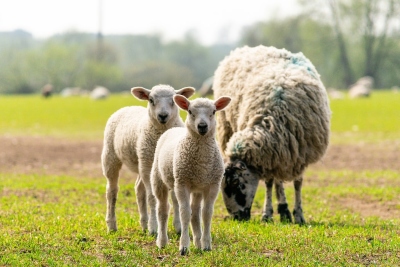Nematodirus battus in Lambs
25 March 2021The life cycle of Nematodirus battus differs from other gastrointestinal worms. Development to infective larvae takes place within the egg, which allows the larvae to survive for long periods on the pasture, surviving cold or dry weather. Hatching of the larvae usually requires particular environments conditions: a period of cold weather followed by a cumulative period of 7-10 days of temperatures over 11ºC. Nematodirus eggs on the pasture shed by lambs the previous year survive through winter and hatch en masse in the spring.
SCOPS and NADIS provide Nematodirus forecasts which predict when the hatch will occur in different parts of the country, although the altitude and aspect of your fields may alter the precise timing of hatch on your farm, with higher altitudes and north facing pastures delaying the hatch.
Lambs
Disease occurs in lambs where they are grazing fields which were grazed by lambs the previous year and are eating significant amounts of grass when the mass hatch occurs (usually from around 6-8 weeks of age). In most flocks lambing in March/April, a hatch occurring in late May/early June, such as this year, can cause sudden death in lambs due to Nematodirus.
It is the immature stages of Nematodirus which disrupt the function of the small intestine of lambs, causing profuse watery diarrhoea, reduced appetite, tucked up appearance and in some cases death. Symptoms of disease occur before any adult worms are present therefore eggs are not reliably detectable in the faeces of affected lambs. Any sudden deaths in lambs should be investigated with a post mortem examination, as this is the only way to diagnose acute Nematodirosis.
Adult Sheep
Adult sheep have developed immunity and are resistant to infection, therefore if the hatch is earlier in the season then some of the Nematodirus larvae are ingested by the ewes, decreasing the level of pasture contamination prior to the lambs starting to graze. Additionally lambs will be gradually exposed as they increase their grass intake and can develop immunity from around 12 weeks of age. In these conditions scour and reduced liveweight gains are the more common presenting signs.
Treatment of affected animals with white drench (1-BZ) is recommended in periods of high risk. Nematodirus resistance to white drenches has only been identified in a small percentage of flocks. The Nematodirus forecast alongside knowledge of your own farm and annual grazing patterns should help with deciding on the timing of treatment.
Fiona Crowden, fiona.crowden@sruc.ac.uk
Sign up to the FAS newsletter
Receive updates on news, events and publications from Scotland’s Farm Advisory Service

